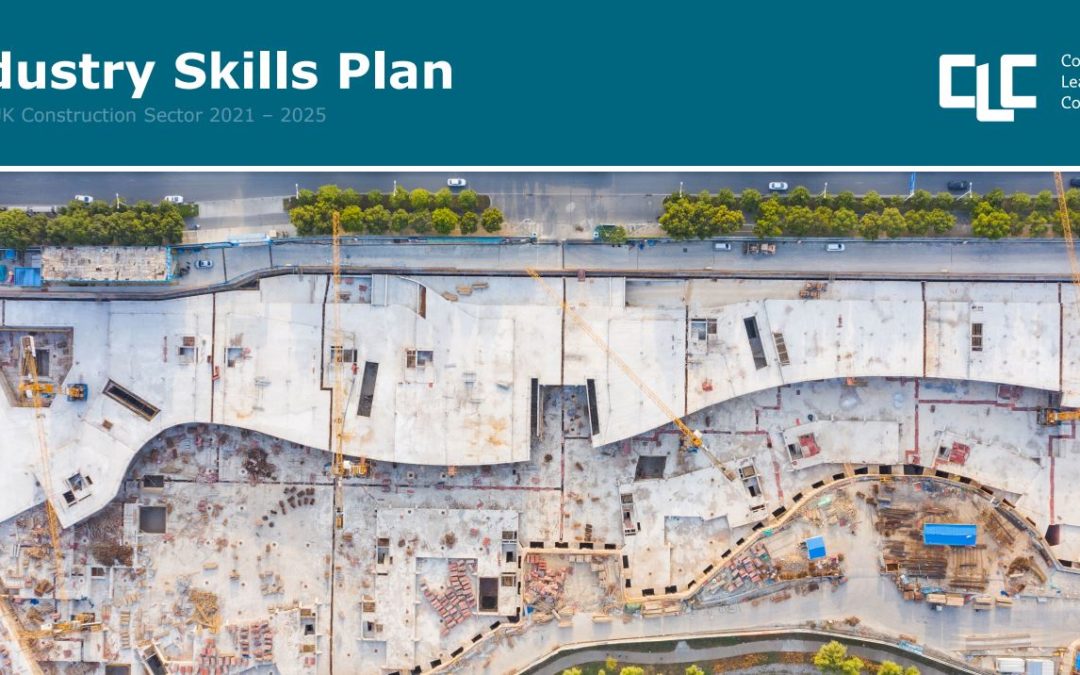
by Iain McIlwee | Mar 11, 2021 | Skills, Transformation
The Construction Leadership Council (CLC) today (Thursday 11 March) publishes the first sector-wide skills plan for construction, developed by Industry.
The Industry Skills Plan for the UK Construction Sector 2021-25 sets out the key skills challenges facing construction and how they will be tackled. The plan sets out a series of clear actions and commitments for both industry and Government to help meet these challenges, grouped under the following four areas:
- Careers
- Standards and Qualifications
- Training, Education and Development
- Culture and Working Environment.
To improve the attractiveness of construction careers and access to them, a Talent View portal will be created, providing a one-stop-shop for new entrants and an industry standard for work experience will be put in place. In addition, up to 7,000 STEM Ambassadors will be encouraged to join the sector-specific Construction and Built Environment scheme, with a target of 1,700 fully supported by 2024.
A set of new construction traineeship programmes, and a pathway from Further Education into construction, will be developed in order to support and boost routes into the industry.
There will be a move to focus of competence by developing new competence frameworks. New training standards will be set in two areas: to support the drive towards Net Zero fossil fuel emissions; and for Smart Construction to develop digital and offsite construction skills. The CLC also supports the drive towards increased direct employment. The plan supports Government mandates on direct employment through procurement.
Mark Reynolds, Group Chief Executive of Mace and CLC member, said: “This is the most ambitious and wide-ranging skills plan the construction sector has ever produced. It should have a far-reaching impact on how we attract, retain and develop people in construction and help deliver upon Government’s home-building and infrastructure plans. “Many of the challenges we address in this plan will require a shared commitment over years, so the hard work starts now to deliver real and lasting change for the benefit of the whole sector.”
Commenting on the Plan FIS CEO, Iain McIlwee stated: “There is some good thinking in the plan and, in the main, it is easy to support and uphold the principles it projects. I do, however, have some concerns over the section on direct employment. We would need to see drastic changes in procurement to enable businesses to employ more. We maybe haven’t got the balance quite right, but with ridiculously short lead times, insufficient allowance in programmes and surge construction when the programme slips, flexibility is essential and that is before you look at the scale and geographic spread of projects in construction and the fact businesses are so easily cast aside in favour of a cheaper quote.
Employment is not the only way to ensure we have an engaged and evolving workforce, indeed the concept of employment has drastically changed in recent times with key tipping points like the introduction of CIS and the death of the final salary pension scheme changing the landscape . We need to be careful of falling into the trap that PAYE is the only way and it was better because we used to employ everybody. I am not convinced construction ever did in the conventional sense (remember the cards?) and there are areas like Health and Safety where we have been able to show marked success. I think we should bring some academic rigour to this part of the plan to better understand the balance and impact on productivity and quality by utilising a freelance contingent and ensure that procurement focusses on how we respect, invest in, manage the competence of and supervise individuals rather than simply how we employ people.”
The plan sets out a series of clear actions and commitments for both industry and Government to help meet these challenges, grouped under the following four areas: Careers; Standards and Qualifications; Training, Education and Development; and Culture and Working Environment. Commitments include:
- Creating Talent View, a one-stop-shop portal for new entrants
- Recruiting 7,000 construction STEM Ambassadors
- Developing an industry standard for work experience
- Producing competence frameworks
- New training standards for Net Zero and Smart Construction
- A pledge to promote direct employment
Details of how to get involved in these commitments will follow in the coming weeks.

by Iain McIlwee | Feb 3, 2021 | Main News Feed, Transformation
This excellent report (published by the Foundation of the Wall and Ceiling Industry and made available to FIS Members via the Association of the Wall and Ceiling Industry -AWCI) explores how construction technology is impacting the means and methods of wall and ceiling construction and draws on original interviews with industry thought leaders working in this sector in the US to provide insight into how technology is transforming the sector.
Background
The need for wall and ceiling contractors to work more productively and safely in today’s labour-constrained construction environment is driving investment in
project management software, tracking and tagging systems and prefabrication machinery at wall and ceiling firms.
“The big drivers for me are productivity, quality and safety,” says Stephen Eckstrom, president, California Drywall Company. “I’m going to adopt more technology
if these [drivers] improve.”
Technology Investment Is Increasing
While many in the commercial construction industry have been slow to adapt to new technologies, according to various sources, technology investment is increasingly being seen as important.
“[Technology] will ensure that your company is positioned to offer new levels of service that may set you apart from competitors,” says Nancy Brinkerhoff, president and CEO of Ironwood Commercial Builders in Northern California and 2019–2020 president of AWCI.
“Companies not on board the automation revolution will be left behind,” says S.S. Saucerman in the AWCI’s Construction Dimensions article, “The Weakest Link? Us.”
How Is Technology Defined?
Technology is “the science or study of the practical or industrial arts,” says Webster’s New World College Dictionary. This definition1 suits the objective of this paper,
which is to discuss “practical” applications that affect the wall and ceiling industry’s workflows. Technology includes software, tools, collaboration methods, ways to
gather and analyse data and more.
What Is Meant by Means and Methods of Construction?
The means and methods of construction is a central principle of construction contracts in which the contractor controls the processes and materials used to build
structures falling within his or her scope of work. Often, contractors must provide their own incidental design input, value engineering or minor plan modifications to resolve on-the-spot difficulties during construction. The goal of contract fulfilment is to complete a project efficiently, profitably and within specifications. This is where investment in technology can have an impact.
A full copy can be downloaded here (FIS Members Only)
Foundation of the Wall and Ceiling Industry
FIS is grateful to the Association of the Wall and Ceiling Industry (AWCI), our sister organisation in the US who has given us permission to share this report with our membership. It is published by The Foundation of the Wall and Ceiling Industry. The Foundation’s mission is to be an active, unbiased source of information and education to support the wall and ceiling industry.

by Clair Mooney | Oct 23, 2020 | Main News Feed, Transformation
In a bid to drive a greater understanding and support the implementation of BIM in the fit-out and finishing world, UK BIM Alliance is delighted to announce a formal affiliation with the trade body for the sector Finishes and Interiors Sector (FIS).
Iain Mcilwee, Finishes and Interiors Sector (FIS) CEO “There is little doubt that, as construction reinvents itself in the post COVID/post Grenfell era, the Digital Revolution is here. If we look at the reforms that will be driven through regulatory requirements or commercial drivers linked to productivity and quality, how we create and share information through the specification and construction process is key. BIM was always going to struggle to live up to the early hype, but the principles of BIM are already helping us to adapt and change and with greater standardisation and simplification, it will help us to deliver the golden thread along with the structural and cultural changes that we need to see. We are very much looking forward to aligning and working more closely with the UK BIM Alliance and helping our community to understand and implement these changes – like with BIM itself, collaboration is everything.”
Andy Boutle, UK BIM Alliance Engagement Co-Lead “We are delighted to welcome FIS to the affiliate programme who already have an active Digital Working Group focussing efforts in this area . We look forward to supporting and coordinating future activities together.”
The Affiliate programme aims to bring together the professional institutions, trade associations and any other industry organisations to provide a consistent message and coordinated approach to digital transformation, working across silos to a shared objective.
About the UK BIM Alliance
We are here to support the built environment sector take the first fundamental step in their journey to digital transformation. The UK BIM Alliance aims to ensure BIM becomes business as usual whilst at the same time, transforming and future proofing the way the industry work. The UK BIM Alliance is also the UK & Ireland chapter of buildingSMART. For more information visit the website.
About the Finishes and Interiors Sector
FIS is the representative body for the £10 billion finishes and interiors sector in the UK. The FIS membership is drawn from contractors, manufacturers and distributors of ceilings, steel framing systems, partitions, operable walls, plastering, drylining, and specialist interior fit-out and refurbishment businesses.
FIS exists to support its members, improve safety, minimise risk, enhance productivity and drive innovation in the sector. As well as specialist publications, technical support and expert helplines, FIS is a dynamic network that brings the sector together through a range of events, awards and specialist working groups, all aimed at sharing best practice, setting standards and advising Government, that help its members to improve performance and win work.
For more information visit the website.

by Iain McIlwee | Oct 15, 2020 | Main News Feed, Transformation
Last week was UK Construction Week, which is a great opportunity to step back and reflect on what has been achieved by the CLC in the past year. One thing that is very clear to me, is that as a result of the Covid19 pandemic, the profile of both construction and the CLC has increased significantly. I was particularly pleased to hear the Construction Minister, Nadhim Zahawi, highlighting examples of our work including the Talent Retention Scheme during his keynote speech at the conference.
The CLC has of course been transformed as a result of our response to Covid-19. We have reformed our structure and organisation; we have increased the tempo of our work in response to the crisis and we are working hard to deliver an Industry Recovery Plan agreed jointly between government and industry last summer.
Yesterday we published a progress review of work on the Recovery Plan. As co-chair, I think that it is useful for me to share my thoughts on the key milestones. Before I do that, I also want to highlight why the plan is so important. Firstly, it is a really positive reflection of a joined-up industry that is thinking collaboratively and strategically about our role in the Covid-19 recovery. Secondly, its content reflects the effective relationship that we have developed with government over the past five years, supporting key objectives that are as diverse as net-zero carbon, skills, and productivity. Thirdly, and most importantly, the plan is being implemented successfully in partnership, and it is making a difference.
Turning to the review itself, I find it a really useful summary of a plan that has many moving parts, all of which play a role in driving the wider recovery. Most of the focus is rightly on our ‘reset’ activities that are supporting the industry to get back on track. Many of these measures, including the Site Operating Procedures, the extension of Right to Buy and flexibility on site working hours are all pragmatic measures that have enabled firms in the sector to work as productively as possible in difficult circumstances. Collaborative work on payment terms and contractual best practice also appears to have made a practical difference to the way in which money flows around the sector. However, I am clear that the biggest achievement of the CLC during the reset phase has been the establishment of the Talent Retention Scheme. As Covid-19 has an inevitable impact on both firms and the people working in our industry, I have a feeling that the TRS will prove to be a real asset as we look to retain our skills base.
Whilst our focus necessarily needs to be on the here and now, I am also really encouraged to see progress on the longer-term Reset and Re-invent phases of the plan which aim to support the longer-term transformation of the sector. Probably the highest profile initiative at the moment is the forthcoming Government Construction Playbook, which will support a stronger and more sustainable relationship between our sector and our government clients. However, there is also great progress being made on initiatives associated with innovation in collaboration with the Construction Innovation Hub, and with building safety, net-zero carbon, and skills.
I am immensely proud of the work that has been achieved by my colleagues on the CLC over the past year. Through a common purpose and tremendous collaboration, I believe that we have taken decisive steps towards our wider transformation to becoming more productive, efficient, sustainable, and safer sector. By taking these steps we will be in a position to consistently deliver value to our clients. I encourage you to read our status report and our plan and to reflect on how you can engage with our programme to not only embed our recovery, but to accelerate our transformation as well.
Blog from Andy Mitchell CBE, Co-Chair of the Construction Leadership Council
CEO Thames Tideway Tunnel
You can read the Building Winter Resilience – New Guidance from the CLC here

by Iain McIlwee | Sep 4, 2020 | Main News Feed, Transformation
A draft recovery plan for the construction sector in Scotland has been launched by the Scottish Construction Leadership Forum (CLF). The plan, which has been created collaboratively with industry, sets out the pathway for joint action between industry and the public sector in response to the impact caused by the global pandemic on the on the construction sector.
The construction industry in Scotland has, like many others, been hit hard by the Covid-19 pandemic. The sector in Scotland which provided £7.8 billion GVA to the Scottish economy and employs 143,000 people in over 50,000 enterprises, is estimated to have contracted by 28.6 per cent in June as a result of the Covid-19 pandemic compared to the same month a year ago (June 2019).
The recovery plan has been created through extensive consultation and collaboration with more than 50 organisations across business, Scottish Government, trades unions and other bodies, including the Construction Industry Coronavirus (CICV) Forum, and represents a shared view from across the sector of a plan to get industry back on its feet.
The plan outlines the immediate and short-term response to Covid-19 and sets out a pathway between this and the longer-term transformation required to build a stronger, fairer and greener economic future for Scotland.
Peter Reekie, chief executive of the Scottish Futures Trust and chair of the editorial group of the Construction Leadership Forum, said: “The construction industry in Scotland has received a major blow from the Covid-19 pandemic. However, the level of collaboration which has gone in to preparing this Recovery Plan is unprecedented and sets a strong foundation for transformative recovery for the industry. I urge all stakeholders with an interest in the construction and related industries in Scotland to feed in your thoughts to make it even stronger.”
Ken Gillespie, chair of the Industry Leadership Group, said: “This plan has only been possible through the depth of collaboration across the sector, and hard work of all involved, and demonstrates the sector’s ability to come together in a time of crisis. This is only the beginning though. The plan will evolve and respond to reflect the feedback and the needs of the sector. We are therefore calling for industry to review and contribute to the plan.”
The plan identifies five areas for concerted and collaborative efforts over the coming months and has established Sub-Groups to develop and progress joint action plans:
- Pipeline & Commercials
- Skills & Workforce
- Transformation
- Supply Chain Resilience & Capability
- Industry Data & Insight
The plan calls for key actions to respond to immediate needs which include:
- A clear pipeline of work brought to market quickly and efficiently on fair commercial terms which reflect the reality of the Covid-19 environment.
- Support of employment, fairness of work and those who may become unemployed through what will be a difficult period.
- Transformation of working practices to maintain and enhance worker safety whilst enabling productivity in the Covid-19 working environment.
Housing Minister Kevin Stewart said: “The construction sector supports many other areas of our economy so it is important that we maintain the health and vitality of the industry. In order to develop this plan, we have reached new heights of collaboration but we are now keen to hear from the wider industry to ensure that we arrive at a plan that will preserve jobs and help to revive our economy.”
The Scottish Construction Leadership Forum (CLF), which has led the development of the plan, is a collaborative initiative of Construction Scotland and the Scottish Government. It was established in March 2019. Chaired by Housing Minister Kevin Stewart for the duration of the crisis, it widened its membership in response to Covid-19 and has already developed and implemented plans to get the industry safely back to work to develop and implement an action plan of improvement initiatives aligned with Government policies and the Construction Scotland Industry Strategy. Several streams of work are ongoing and prior to Covid-19, the Forum was at the early stages of considering a wider agenda for change across the industry.
The CLF shared vision is of an industry that promotes a safe, productive, profitable, digitally-enabled, low-carbon, and socially responsible construction industry which offers quality jobs and fair work to a highly skilled and diverse workforce and a quality and life-time value product to its customers.
The recovery plan is available to view on https://www.constructionforum.scot/.
Industry is invited to send feedback, comments and questions via the website on enquiries@constructionforum.scot by 15 September. CLF will take all feedback on board to help develop the plan further, with regular updates published on the CLF site.
ENDS

by Iain McIlwee | Jul 17, 2020 | Main News Feed, Transformation
Hosted by journalist Dan Walker, the Construction Products Association Live Debate – The Future of the Construction Industry pulled together experts, including our own CEO Iain McIlwee to interrogate the impact of COVID-19 on the future of the construction sector. Topics covered included:
- The Covid-19 pandemic has seen one of the greatest hits to both the UK economy and the UK construction industry on record. In its most recent Construction Industry Scenarios, the CPA estimates total construction output in Great Britain is expected to fall by 25% during 2020. Its most optimistic scenario doesn’t expect the industry returning to 2019 levels until early 2022, its more pessimistic ones won’t see it return to 2019 levels until Q1 2023.
With this in mind what could recovery look like?
- The CPA highlights that productivity on site has fallen by 30-40% recently (depending on site size) give social distancing measures. The construction industry has always adapted and evolved and with this in mind can you give some examples of where the industry has already adapted and started to improve on this by new ways of working. Are there others ways the supply chain can help the industry and the Country recover?
How will the construction industry really use this crisis as an opportunity to change itself and work more collaboratively?
- The Government has sent out sometimes contradictory messages about its expectations around things like standards, building regulations and planning, which might be confusing for much of our audience. Government talks, for example, of full support for net-zero and safer, better quality homes and buildings, but then it also suggests it would be willing to walk away from standards and regulatory alignment established with the EU, and to loosen planning regulations.
Is there a ‘disconnect’ here? And how is the construction industry supposed to plan, invest, train, innovate, and really put your shoulder to the wheel if the signals from your biggest client are unclear?
- Looking ahead, Prime Minister Boris Johnson promised a ‘Rooseveltian’ programme of investment in Britain and has pledged to “build, build build” to bring the country out of recession after the coronavirus pandemic. The PM has announced a ‘New Deal’ with £5bn investment to accelerate infrastructure projects, create jobs and revitalise the economy. The CPA’s Economics team has pointed out however that this investment in “not new, additional money despite the spin behind it.”
What more do you think the government can do to stimulate construction activity and where should attention be focused? We heard the Chancellor’s announcement on energy-efficient retrofit last week, but what else could be done, for example, to boost house building, or on infrastructure delivery?
- We have seen so many fantastic examples of our industry stepping up during this crisis, from charity events and fundraising to donations of materials and PPE to various organisations and, of course, maintaining building and maintenance work on essential projects and infrastructure such as the Nightingale Hospitals.
What advice would you give to colleagues across the industry to ensure they all stay safe whilst helping the country recover?
The panel of experts included Peter Caplehorn, CPA; Philip Johns, SIG plc; Graham Edgell, Morgan Sindall; Angela Mansell, Mansell Finishing; Stacey Temprell, British Gypsum; Iain McIlwee, FIS; James Talman, NFRC and Jon Sinfield, BMI UK & Ireland.
The event was sponsored by FIS Members British Gypsum and SIG plc
You can access the recording of the event here
Page 6 of 7« First«...34567>






